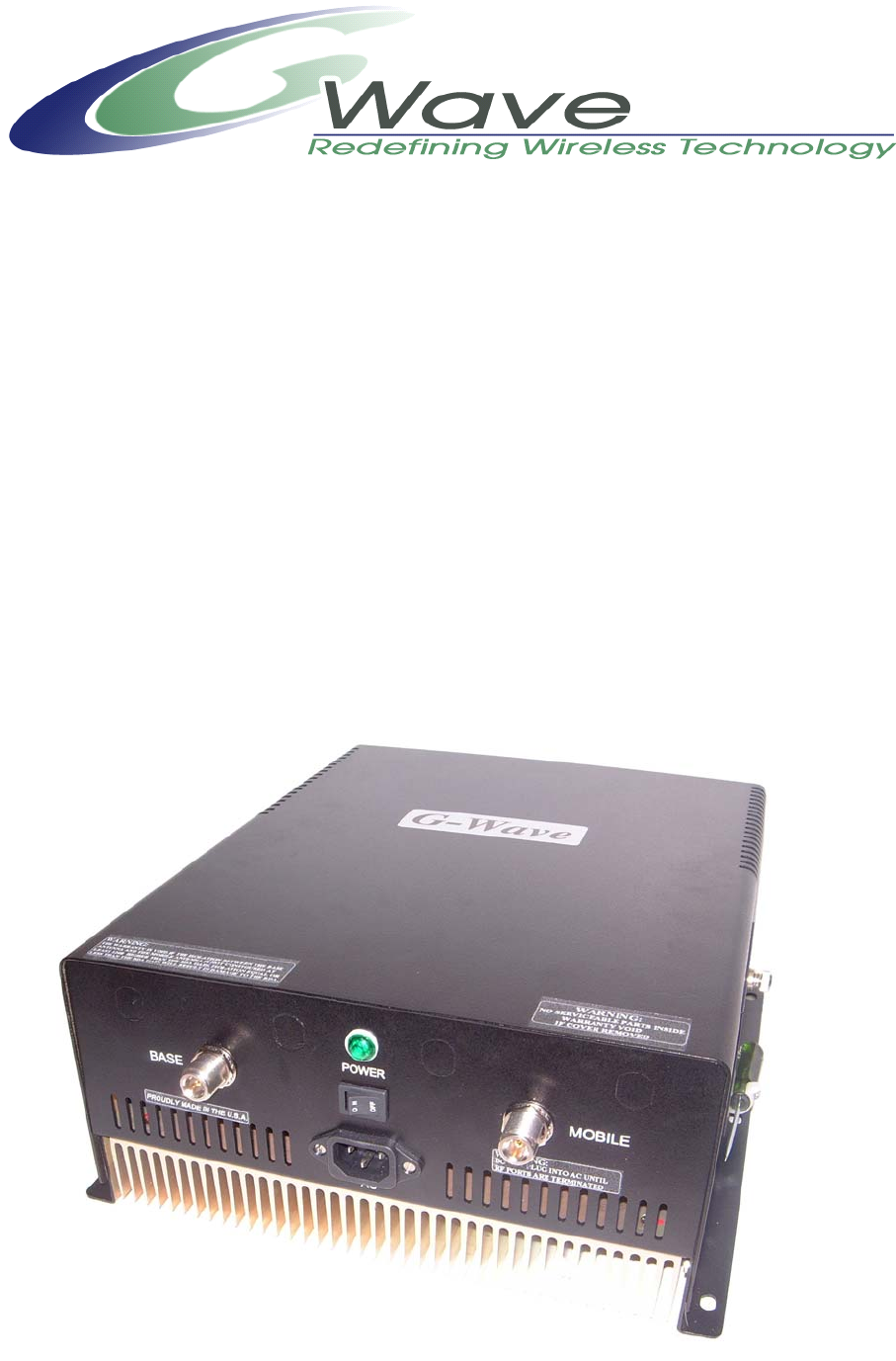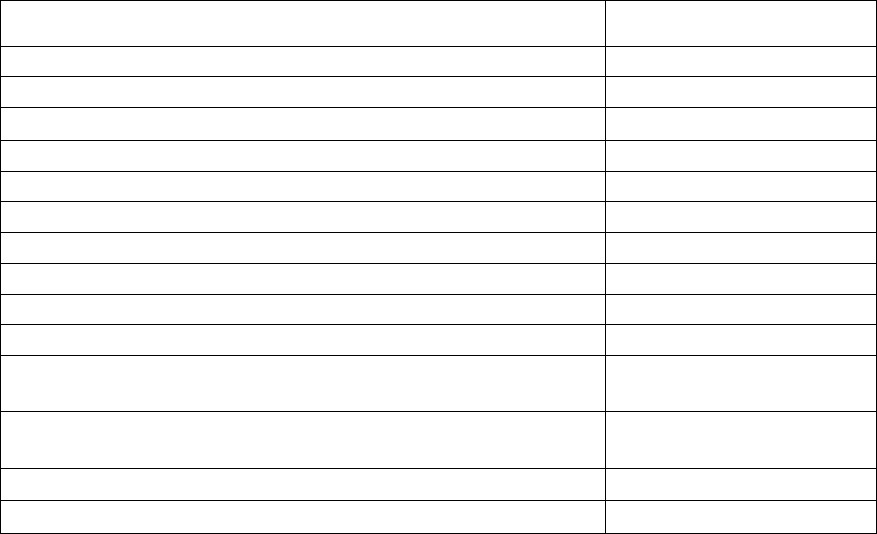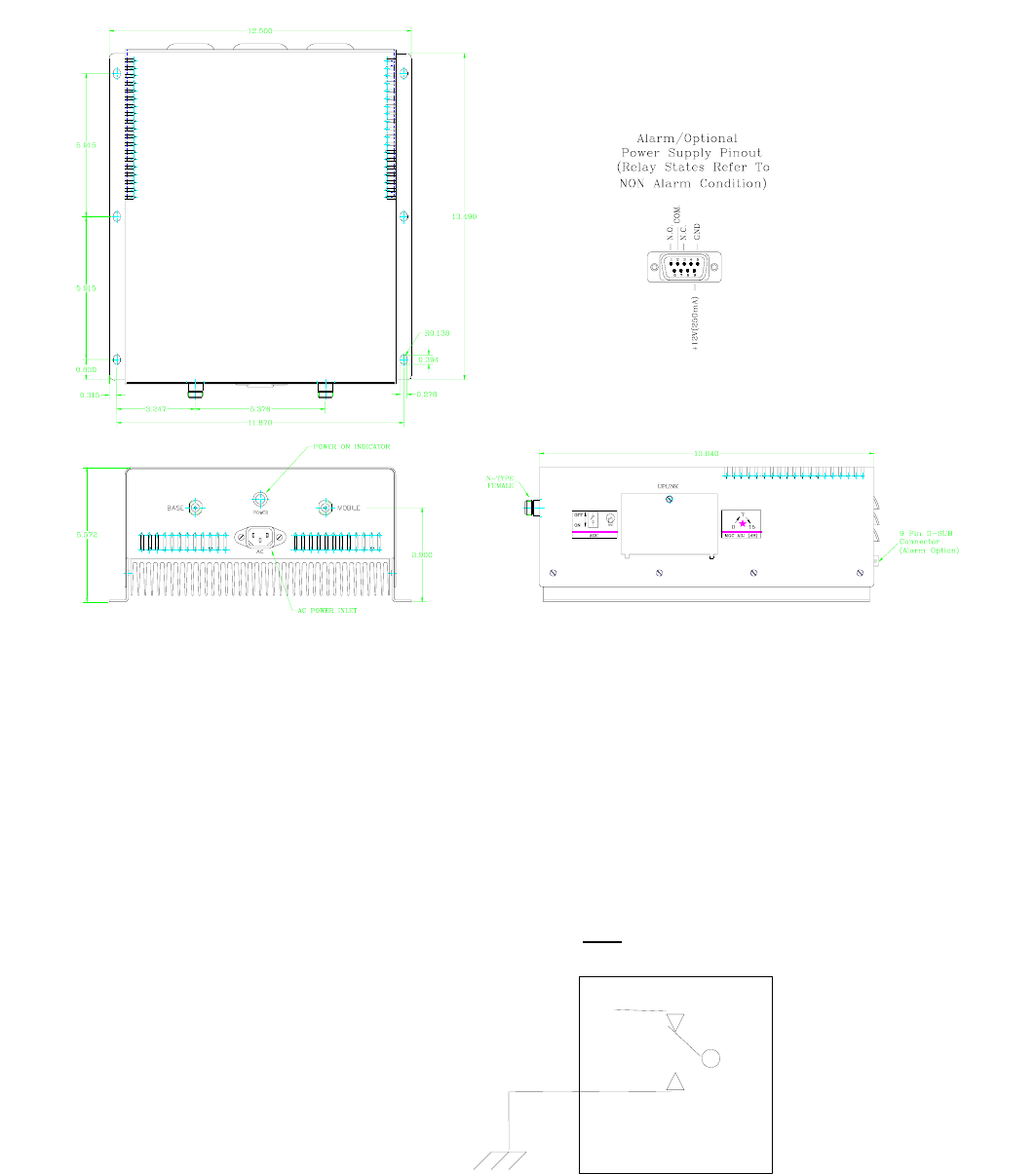G Way Solutions PS7PS810W80 DUAL BAND RF BI-DIRECTIONAL AMPLIFIER User Manual USERS MANUAL
G-Way Microwave / G-Wave DUAL BAND RF BI-DIRECTIONAL AMPLIFIER USERS MANUAL
USERS MANUAL

INSTALLATION
AND
OPERATING MANUAL
BDA-PS7/PS8-2/10W-80-A
DUAL BAND BI-DIRECTIONAL AMPLIFIER

TABLE OF CONTENTS
PARAGRAPH PAGE NO
BDA OVERVIEW 3
BDA BLOCK DIAGRAM DESCRIPTION 3
BDA BLOCK DIAGRAM DRAWING (Figure 1) 4
ELECTRICAL SPECIFICATIONS 5
MECHANICAL SPECIFICATIONS 6
ENVIRONMENTAL CONDITIONS 6
BDA CONNECTIONS 6
MECHANICAL OUTLINE DRAWING (Figure 2 & 2a) 7
BDA INSTALLATION 8
BDA OPERATION 9
UPLINK MECHANICAL OUTLINE- ADJUSTMENT
(Figure 3) 10
DOWNLINK MECHANICAL OUTLINE- ADJUSTMENT
(Figure 4) 11
RF EXPOSURE WARNING 12
DIAGNOSTICS GUIDE 12
Page 2

BDA OVERVIEW:
The BDA assembly extends the coverage area of radio communications in buildings
and RF shielded environments. The BDA has dual RF paths to extend coverage in
two distinct frequency bands.
The unit features low noise figure and wide dynamic range. It is based on a duplexed
path configuration with sharp out of band attenuation allowing improved isolation
between the receiving and transmitting paths.
BDA BLOCK DIAGRAM DESCRIPTION:
Refer to figure 1 for the following discussion.
The BDA Downlink path receives RF signals from the base station and amplifies and
transmits them to the subscriber. The BDA Uplink path receives RF signals from the
subscriber and amplifies and transmits them to the base station. The Uplink and
Downlink occupy three distinct frequency bands. The frequency bands are as follows:
794-824 MHz for the Uplink and 764-776 MHz & 851-869 MHz for the Downlink. Two
triplexers isolate the paths and route each signal to the proper amplifying channel.
An Automatic Level Control (ALC) allows for output power limiting. A variable step
attenuator gives 0 – 30 dB of attenuation in 2 dB steps. The use of these controls is
covered in the “OPERATION” section, later in this document.
Page 3

ELECTRICAL SPECIFICATIONS:
Frequency Range
Downlink : 764-776 and 851-869 MHz
Uplink : 794-824 MHz
Pass band Gain @ min attenuation : 80 dB minimum
Variable Step Attenuator Range : 0-30 dB
(2-dB steps)
Pass band Ripple : ±1.5 dB (typ)
Noise Figure @+25°C at max gain : 5.5 dB max
3rd Order Intercept point
Uplink : +46 dBm (typ)
Downlink : +49 dBm (typ)
*Output Power @ 1dB Compression
Uplink : +33 dBm (typ)
Downlink : +39 dBm (typ)
*ALC Factory Set Point
Uplink : +25 dBm
Downlink : +32 dBm
Isolation between Up/Down Link : 100 dB min
Input/ Output Impedance : 50 Ohms
VSWR (Input/Output) : 1.5: 1 max
Pass band Gain @ min attenuation : 80 dB minimum
Power Supply : 110VAC/1.42Amp
: 240VAC/0.71 Amp
: 50 to 60 Hz
*The Manufacturer's rated output power of this equipment is for single carrier operation. For situations
when multiple carrier signals are present, the rating would have to be reduced by 3.5 dB, especially
where the output signal is re-radiated and can cause interference to adjacent band users. This power
reduction is to be by means of input power or gain reduction and not by an attenuator at the output of
the device.
Page 5

MECHANICAL SPECIFICATIONS:
Size : 13.5 x 12.5 x 5.6 inch
: (343 x 317.5 x 142.3 mm)
RF Connectors : N-type Female
Weight : 20.9 Lbs. (9.5kg.) approx.
ENVIRONMENTAL CONDITIONS:
The unit is designed for indoor applications:
Operating temperature: - 20°C to + 50°C
Storage temperature: - 50°C to + 90°C
BDA CONNECTIONS
The BDA AC power is accepted through a standard 3-wire male plug (IEC-320) with
phase, neutral and ground leads. The AC power is wired to a high efficiency DC
switching power supply which is CE and UL approved. The power supply runs the
amplifiers and the Power On lamp. The metal enclosure of the BDA is connected to
ground.
A 9-pin D-Sub connector provides failure alarm output contacts (see diagram next
page) as well as an optional 12 VDC (250mA) auxiliary output.
The RF connections are made via two type “N” female connectors. The RF connector
labeled “BASE” must be connected to the antenna pointing towards the base station.
The RF connection labeled “MOBILE” must be connected to the antenna facing the
area to be covered by the BDA.
The RF connections must be made through cables with characteristic impedance of
50 ohms.
The isolation between the base station antenna and the mobile antenna should
be at least 12 dB higher than the BDA gain. Isolation less than this value can
cause gain ripple across the band. Isolation equal to or less than the BDA gain
will give rise to oscillations which will saturate the amplifiers and possibly
cause damage to the BDA.
Page 6

N.O.
COM.
N.C.
Figure 2
BDA Mechanical Outline
Figure 2a
(Relay Shown in
Non-Alarm Condition)
The alarm monitors current of both uplink
and downlink amplifiers. An alarm condition
will occur if either uplink or downlink amplifiers
are over or under its current tolerance.
Page 7
Conditions for Optional Alarm
IN BUILDING REPEATER

BDA INSTALLATION
DO NOT APPLY A.C. POWER TO THE BDA UNTIL CABLES ARE
CONNECTED TO BOTH PORTS OF THE BDA AND THE ANTENNAS.
1. Mount the BDA on the wall with the RF connectors pointing DOWN. Using
appropriate screws and anchors, attach the BDA to the wall at the four mounting
holes on the side flanges.
2. Ensure that the isolation between the donor antenna and the service antenna is at
least 12 dB greater than the BDA gain. (Use the higher of the Uplink and Downlink
gains reported on the BDA test data sheet).
3. Connect the cable from the donor antenna to the BDA connector labeled “BASE”
and the cable from the service antennas to the BDA connector labeled “MOBILE”.
4. Open the adjustment access panels on the sides of the BDA and verify that both of
the attenuator’s are positioned to its maximum setting (30 dB). Close the panels.
5. Connect the AC power cord to the BDA and then to the power source. Verify that
the “Power ON” lamp is illuminated.
Installation of the BDA is now complete. To adjust the gain controls to suit the
specific signal environment, refer to the next section of the manual.
Note: For repeat installations of existing equipment, make sure the attenuation
is positioned to its maximum setting (30 dB). After verification of the
attenuation, follow the above steps starting with step 1.
Page 8

RF EXPOSURE WARNING
The antenna used for this transmitter must be fixed-mounted on outdoor permanent
structures. In order to satisfy the FCC RF exposure requirements, the BDA/antenna
installation must comply with the following:
The downlink indoor antenna (Omni type or similar directional antenna) must be installed so
as to provide a minimum separation distance of 0.35 meters (35 cm) between the antenna
and persons within the area. (This assumes a typical antenna with maximum gain of [2 dBi,
VSWR >?> 1.5:1, Zo= 50 ohms, and a cable attenuation of between 2-10 dB)
The uplink outdoor antenna (Yagi type or similar directional antenna) must be installed so as
to provide a minimum separation distance of 0.35 meters (35 cm) between the antenna and
persons within the area. (This assumes a typical antenna with maximum gain of [13 dBi,
VSWR >?> 1.5:1, Zo= 50 ohms, and a cable attenuation of between 2-10 dB).
DIAGNOSTICS GUIDE
The BDA provides long term, care-free operation and requires no periodic maintenance.
There are no user-serviceable components inside the BDA. This section covers possible
problems that may be related to the installation or operating environment.
a. Gain Reduction
Possible causes: Bad RF cables and RF connections to antennas, damaged antennas.
b. Excessive Intermodulation or Spurious
Possible causes:
Amplifier oscillation caused by insufficient isolation. The isolation between two antennas is
given by the equation:
Isolation = 92.5 + 20 Log (F x D) – Gt – Gr
Where:
F = frequency (GHz) Gt = transmit antenna gain (in the direction of the receive antenna)
D = separation (Km) Gr = receive antenna gain (in the direction of the transmit antenna)
For example, at the SMR frequencies, the antenna isolation at 100 m separation is about 71
dB for omni-directional antennas (0 dB gain). To increase isolation, the antennas should
have higher directivity and must be pointed away from each other.
c. Occasional Drop-out of some Channels
Possible causes: One channel with very strong power dominates the RF output of the
amplifier.
38 Leuning Street
South Hackensack, NJ 07606
Tel. 201-343-3140 Fax 201-343-6390
sales@gwaverf.com
www.gwaverf.com
Page 12